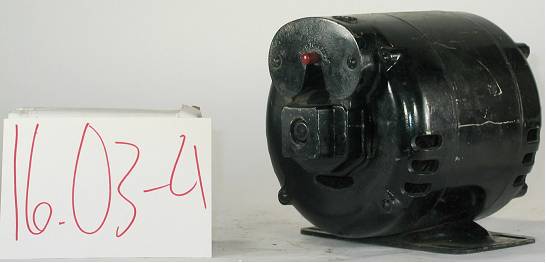Electric Motors – Single Phase, Split Phase
An early mid 20th century split phase, induction motor with ball bearings, built for the then rapidly expanding home workshop equipment industry in post W.W.II Canada, equipped with hefty 1/2 horsepower rating and manual reset over load protection, it would be a marker of a significant cultural shift in male leisure time pursuits, Delco, Circa 1958.
Features:
Shop service tag in Howard Olivers hand writing “Checks OK Jan, 75
Technical Significance:
Exemplifies the evolution of inherent, automatic overload protection devices with manual reset, a prerequisite requirement for home hobby shop equipment:
Such applications typically rewired low starting torque [as on circular saws, but moderate horse power, current ratings, which could readily lead to burn out under high load conditions
Motors were built for an affordable market and were built inexpensively, with little tolerance for prolonged loading [over loading],
While automatic overload protection was considered an essential safety precaution, both for personal and property reasons, automatic reset would constitute a safety hazard, allowing the equipment to come back on out of control of operator,
Defines the engineering design idiom for split-phase, low starting torque, motor technology employed throughout the middle years of the 20th century in home appliances and hobby shop equipment, moving through the mature years of this genre towards the end of the century, when a new genre would progressively emerge, smaller, lighter and more energy efficient.
Industrial Significance:
The motor stands as a relatively rare marker of a breed of home hobby shop motor which would soon disappear. The stand alone, home hobby shop motor as a product of the post W.W.II market place, would be a relatively short lived phenomena. Early power tools of the period were, designed for the home work shop were of the conventional belt drive type, through the 1950’s to 80’s, but the trend was increasingly to much more integrated designs in which the motor was built into the equipment, itself, as an inherent design component.
A marker of split phase electric motor production in Canada and the US, in the latter years of the 20th century. Manufactured in the hundreds of thousands, by Delco, GE and other manufacturers, it stands as an icon of its times, marking the first great period mass production and marketing of electric, motorized household appliances and hobby shop equipment, now made possible by wide spread home electrification.


